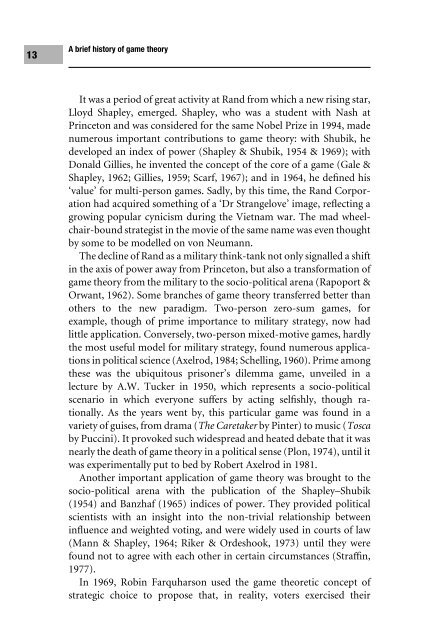Decision Making using Game Theory: An introduction for managers
Decision Making using Game Theory: An introduction for managers
Decision Making using Game Theory: An introduction for managers
- No tags were found...
You also want an ePaper? Increase the reach of your titles
YUMPU automatically turns print PDFs into web optimized ePapers that Google loves.
13A brief history of game theoryIt was a period of great activity at Rand from which a new rising star,Lloyd Shapley, emerged. Shapley, who was a student with Nash atPrinceton and was considered <strong>for</strong> the same Nobel Prize in 1994, madenumerous important contributions to game theory: with Shubik, hedeveloped an index of power (Shapley & Shubik, 1954 & 1969); withDonald Gillies, he invented the concept of the core of a game (Gale &Shapley, 1962; Gillies, 1959; Scarf, 1967); and in 1964, he deWned his‘value’ <strong>for</strong> multi-person games. Sadly, by this time, the Rand Corporationhad acquired something of a ‘Dr Strangelove’ image, reXecting agrowing popular cynicism during the Vietnam war. The mad wheelchair-boundstrategist in the movie of the same name was even thoughtby some to be modelled on von Neumann.The decline of Rand as a military think-tank not only signalled a shiftin the axis of power away from Princeton, but also a trans<strong>for</strong>mation ofgame theory from the military to the socio-political arena (Rapoport &Orwant, 1962). Some branches of game theory transferred better thanothers to the new paradigm. Two-person zero-sum games, <strong>for</strong>example, though of prime importance to military strategy, now hadlittle application. Conversely, two-person mixed-motive games, hardlythe most useful model <strong>for</strong> military strategy, found numerous applicationsin political science (Axelrod, 1984; Schelling, 1960). Prime amongthese was the ubiquitous prisoner’s dilemma game, unveiled in alecture by A.W. Tucker in 1950, which represents a socio-politicalscenario in which everyone suVers by acting selWshly, though rationally.As the years went by, this particular game was found in avariety of guises, from drama (The Caretaker by Pinter) to music (Toscaby Puccini). It provoked such widespread and heated debate that it wasnearly the death of game theory in a political sense (Plon, 1974), until itwas experimentally put to bed by Robert Axelrod in 1981.<strong>An</strong>other important application of game theory was brought to thesocio-political arena with the publication of the Shapley–Shubik(1954) and Banzhaf (1965) indices of power. They provided politicalscientists with an insight into the non-trivial relationship betweeninXuence and weighted voting, and were widely used in courts of law(Mann & Shapley, 1964; Riker & Ordeshook, 1973) until they werefound not to agree with each other in certain circumstances (StraYn,1977).In 1969, Robin Farquharson used the game theoretic concept ofstrategic choice to propose that, in reality, voters exercised their
















